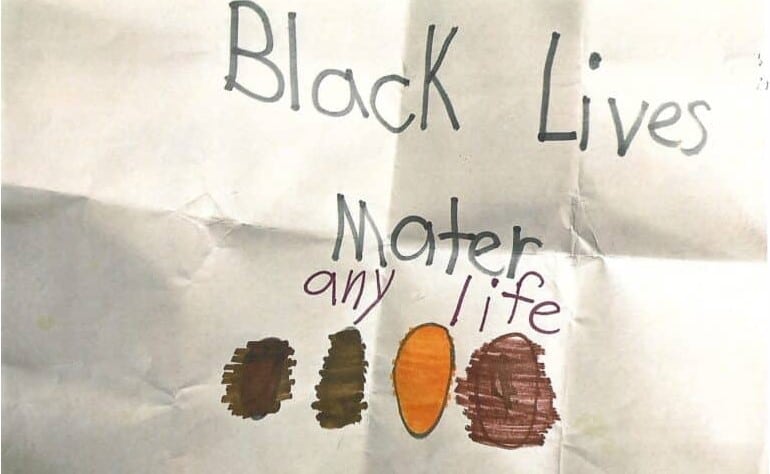How much freedom of speech does a first-grader have? That’s the question on appeal to the 9th U.S. Circuit Court of Appeals.
The appeal stems from a surprising ruling earlier this year by the U.S. District Court for the Central District of California that a public school had the right to punish a 7-year-old girl for sharing a drawing with a first-grade classmate.
B.B. was moved to paint a picture for her friend after her teacher told the class about Dr. Martin Luther King Jr. and used the phrase “Black Lives Matter.” B.B.’s drawing depicted four friends, apparently of different racial backgrounds, beneath the message “Black Lives Mater(sic)” and “Any Life.”
According to deposition testimony and acknowledged by the judge, this was an innocent effort to be nice to her friend. The first-grader receiving the picture took it as such and brought it home with her.
That’s when everything changed. The black girl’s mother called the school, concerned that her daughter was being singled out because of her race.
The Pacific Legal Foundation, which is bringing the appeal on behalf of B.B.’s mother, provided this narrative:
“The principal confronted B.B. and explained that including the phrase “any life” in the drawing was “inappropriate” and “racist,” and he forced B.B. to apologize to her classmate. B.B. would also no longer be allowed to draw pictures in school. Worse still, the 7-year-old was not allowed to go to recess for two weeks. Instead, she had to sit and watch her friends play without her.”
It was pretty much “Hold it right there, kid, back away from the crayons.”
The 7-year-old in all of us recognizes the severity of a two-week ban on recess and an order not to draw anymore.
This matter should have been resolved long ago with an apology by the school district. That didn’t happen, so litigation was filed.
B.B. has a rich body of law on her side. The Supreme Court has repeatedly said that free-speech rights are not contingent upon age. In the pivotal case of Tinker v. Des Moines Independent Community School District, upholding the right of students to wear black armbands in a peaceful protest against the war in Vietnam, the Court held:
“State-operated schools may not be enclaves of totalitarianism. School officials do not possess absolute authority over their students. Students … are possessed of fundamental rights which the State must respect,” the Court found.
Yet Judge David Carter concluded that B.B.’s drawing was not protected by the First Amendment, in part because the two little girls were only 7 and that schools had leeway to control speech when the speech is directed at a member of a minority, saying that though B.B. didn’t intend it as such, the phrase on her drawing was “one that is widely perceived as racially insensitive and belittling when directed at people of color.” The concern is that a young child could be traumatized by the speech, the judge wrote.
The reality is that the only child being traumatized was the one treated as a criminal by the school system after she sweetly gave her friend a gift.
Yes, the girls were 7, but there’s no age limit on constitutional protections. Even babies have a semblance of protection, though it takes some time for the whole speech thing to kick in. The girls’ age means it all went over their heads. They were friends then; they’re friends now.
Cases involving free speech in public schools almost always turn on whether there is a significant likelihood of substantial disruption in the educational system, but in this case there was no disruption, and would never have been any.
If the school system was genuinely concerned that B.B. was going to be a prolific drawing distributor who would turn the school on its head, don’t you think the first call would have been to B.B.’s parents to give her a little guidance on proper behavior? That call wasn’t made. The school went straight to punishment.
To be clear, parents have almost absolute control over how their children are raised, but this is the government – not Mom and Dad – punishing a well-meaning child without her parent’s knowledge.
While we’re not accustomed to thinking much about the speech of 7-year-olds, it’s critical to recognize that infringements on our most fundamental freedoms can come at any age.
Thanks to the good work of the Pacific Legal Foundation, the 9th Circuit has an opportunity to make clear that even young children have First Amendment rights in a public school. Those rights are not unlimited, but they’re also not inconsequential. It’s a lesson for us all.
Ken Paulson is the director of the Free Speech Center, dean emeritus at Middle Tennessee State University and a former editor in chief of USA Today.
The Free Speech Center newsletter offers a digest of First Amendment- and news media-related news every other week. Subscribe for free here: https://bit.ly/3kG9uiJ

